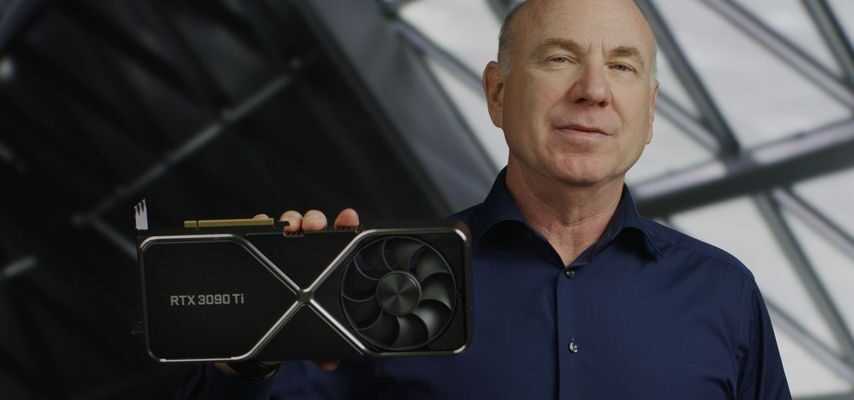GeForce Now, Reflex, DLSS and RTX technologies which continue to deploy more widely: Nvidia had more than one reason to rejoice in the past year at the opening of CES 2022, despite a gloomy context on the side of the component availability. However, by dint of unrolling the long list of its past successes, it was believed that the brand had forgotten its future, and in particular that of the players. Fortunately, if it is true that the bulk of the announcements mainly concerned the professional and industrial world, fans of video game entertainment were able to take advantage of a few new features: four graphics products, the RTX 3050 and 3090 Ti for the desktop world, and the RTX 3070 Ti and 3080 Ti for the mobile part.
On the desktop PC side, Nvidia is extending the spectrum of the Ampere generation, which until now went from the RTX 3060 to the RTX 3090, with two new cards at the antipodes. The RTX 3090 Ti will thus become the new spearhead of its generation, and if Nvidia has remained silent in terms of specifications, the rumors which preceded the official announcement point to a theoretical power very slightly higher than that of the RTX 3090: 10,752 CUDA cores on the counters (compared to 10,496 previously), 84 RT (compared to 82), and increased frequencies, whether on the GPU or memory. Note that the quantity of GDDR6X remains stable, with 24 GB available. Ladlely, we are betting on a performance gain of 10% on average, 10% of which we have no doubt that they will be traded at a high price, especially in the current context.
A price to which it will undoubtedly be necessary to add that of a triple XL power supply: as a reminder, an RTX 3090 already demanded in full video game load the trifle of 370 Watts, and if we count the solid latest generation processor that must go with it. , the energy bill increases from 250 to 350 Watts depending on the model. A few additional components and some leeway later, we could estimate the overall power requirements around 750 – 800 Watts. For the 3090 Ti, it would not be surprising to have to add 100 to 150 Watts of bonus… The word you are looking for when reading these figures is therefore certainly “OuchAnyway, Nvidia refers us to future communications for more details, whether on specifications, launch date or pricing.
The RTX 3050 is intended to be more concrete, and intends to cover more interesting ground for the general public (in theory), since it will sign the arrival of a new floor price, for access to RTX technologies and DLSS (among other things). While the RTX 3060 was launched at an official price of $ 329 (ex VAT), the new RTX 3050 is targeting $ 249 (ex VAT). Of course, we all know what the difficult reality of the market currently implies: you will never have a 3050 in this price zone, the 3060 itself being nowhere to be found below the € 670 mark. Still, the newcomer will necessarily arrive at a lower price … It’s already won.
To read also | Our test of the GeForce RTX 3080 Ti
As for performance, it could remain very interesting, thanks to the 2560 Computing Units, the 1780 MHz of Boost frequency, and the 8 GB of GDDR6 memory on a 128-bit interface, but not only. DLSS support should bring a big plus for compatible titles (and often GPU resource intensive). Side timing, Nvidia plans to arrive on the market on January 27th. Note that like the RTX 3060, the RTX 3050 will only be released as a partner version. Too bad: the “Founders” models were generally the only ones that we could have a small chance of finding at the official price.

Fortunately, the laptop market is experiencing less tension, and the two mobile GPUs announced in parallel should be deployed in reasonable price ranges. Interested parties should be able to afford a machine equipped with RTX 3070 Ti from $ 1,499 (excl. VAT), while a laptop PC equipped with RTX 3080 Ti will reserve its favors for budgets starting at $ 2,499. As often, the performance elements delivered by Nvidia are impressive, but it should be remembered that these, especially on high-end GPUs, remain very dependent on the quality of the integration (chassis, associated cooling system, etc.) ). And in our experience, on 20 series mobile products, it was not uncommon to encounter cases where the GPU remained constrained by weaknesses in design associated.
However, we note that Nvidia continues to optimize the use of its mobile chips: this CES 2022 is thus the opportunity to launch the fourth iteration of the Max-Q system. On the program, we find in particular CPU Optimize, which will seek to distribute the available energy envelope as well as possible between CPU and GPU. the Rapid Core Scaling, meanwhile, intends to optimize the use of GPU cores in order to achieve higher operating frequencies.

The first machines bringing together all new products should appear on the market from February 1 at Acer, Asus, Alienware, or MSI, to name a few.

To read also | The best graphics cards for your PC
